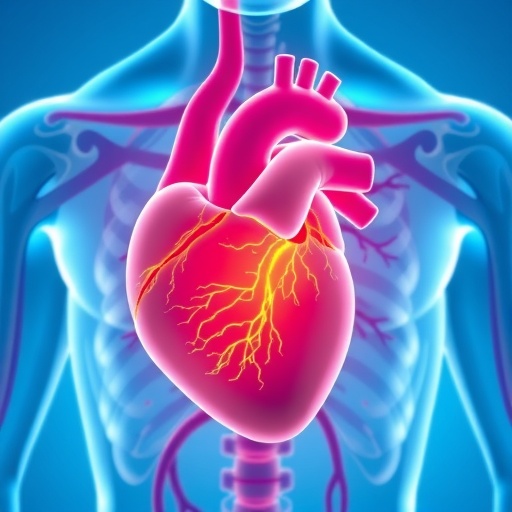An Emerging Paradigm in Heart Failure: The Adipokine Hypothesis Unveils Fat’s Role in HFpEF
Heart failure with preserved ejection fraction (HFpEF) has long presented an enigma in cardiovascular medicine. Characterized by a stiff heart muscle that fails to accommodate incoming blood adequately, HFpEF affects millions globally yet has resisted unifying explanation and effective treatment strategies. A groundbreaking new framework, termed the Adipokine Hypothesis, proposes that alterations in the biology of internal fat tissue—rather than previously emphasized factors like hypertension—underlie the majority of HFpEF cases. This paradigm-shifting hypothesis, authored by Milton Packer, MD, FACC, and published today in the Journal of the American College of Cardiology (JACC), advances our understanding of how fat tissue biochemistry disrupts cardiac function.
Traditionally, HFpEF was linked primarily to elevated blood pressure, which was thought to induce stiffness in the heart muscle. However, emerging data challenge this perspective, indicating that nearly all HFpEF patients harbor significant accumulations of internal fat surrounding vital organs, including the heart itself. Unlike subcutaneous fat, this visceral and pericardial adiposity engages in complex biochemical signaling that profoundly impacts cardiac structure and function. The Adipokine Hypothesis explicates these interactions and their pathophysiological consequences.
Adipokines are bioactive signaling molecules secreted by adipose tissue; in physiologic states, they maintain homeostasis by downregulating inflammation, supporting vascular and renal health, and modulating fluid balance. This harmonious crosstalk ensures cardiovascular resilience. In contrast, the presence of excessive internal fat tissue invokes a pathological transformation in adipokine secretion profiles. The altered adipokines potentiate inflammation, oxidative stress, and fibrotic remodeling within the myocardium, fostering the hallmark stiffness observed in HFpEF. Thus, the heart is not merely passively affected by extrinsic pressure but is actively injured via maladaptive molecular signals emanating from surrounding fat depots.
Experimental pharmacological studies corroborate this mechanistic framework. Therapeutic agents that target fat tissue biology—rather than the myocardium itself—have demonstrated efficacy in alleviating HFpEF phenotypes. These drugs modulate adipokine secretion, attenuate cardiac fibrosis, and improve diastolic function, thus validating the hypothesis that fat is a central driver rather than an innocent bystander. Notably, several such agents already bear FDA approval for HFpEF treatment but remain underutilized in clinical practice. Additionally, glucagon-like peptide 1 (GLP-1) receptor agonists, including semaglutide and tirzepatide, have shown promising adipokine-modulating effects, potentially offering another therapeutic avenue.
Measuring fat-related risk factors also demands refinement. Body mass index (BMI), a conventional indicator of obesity, fails to distinguish between adiposity and lean mass, leading to diagnostic ambiguity. Instead, waist-to-height ratio has emerged as a more reliable metric for identifying individuals with excessive internal fat accumulation. A ratio exceeding 0.5 signals heightened risk, and most patients with HFpEF have ratios surpassing 0.6. This simple anthropometric measure enables clinicians to screen more effectively for HFpEF risk and initiate timely evaluation for symptomatic patients frequently misattributing exertional breathlessness to mere obesity.
The clinical implications extend beyond diagnostics. Early recognition of aberrant adipokine signaling and its cardiac consequences enables targeted interventions. Patients with elevated waist-to-height ratios presenting with dyspnea on exertion should undergo thorough HFpEF assessment. This approach can prevent underdiagnosis and mismanagement, offering opportunities to deploy therapeutics that reverse fat-mediated cardiac injury and improve quality of life.
The Adipokine Hypothesis echoes the transformative impact of Packer’s earlier work on heart failure with reduced ejection fraction (HFrEF). Over three decades ago, he introduced the neurohormonal hypothesis, redefining heart failure pathophysiology and guiding new therapeutic developments. The current hypothesis similarly reshapes the conceptual landscape of HFpEF, a condition historically marked by limited therapeutic options and prognostic ambiguity.
To complement this foundational paper, two additional studies published concurrently in JACC: Heart Failure delve into related molecular mechanisms. One explores the influence of eicosanoid adipokines in orchestrating inflammation within the HFpEF milieu, while the other investigates adipoexosomal microRNAs as novel regulators of cardiac fibrosis and remodeling. Together, these investigations provide a multi-dimensional understanding of how fat tissue reprogramming disrupts cardiac homeostasis at both systemic and molecular levels.
The Adipokine Hypothesis galvanizes a shift toward precision cardiovascular medicine, where interventions focus on modulating the biochemistry of adipose tissue rather than solely attempting to palliate heart muscle dysfunction. This paradigm shift holds promise for addressing the vast and growing global burden of HFpEF, a syndrome presently impacting nearly 4 million Americans and over 32 million individuals worldwide. As obesity rates climb, untangling fat’s complex role in cardiovascular disease becomes increasingly vital.
In summary, the Adipokine Hypothesis elucidates a previously underappreciated etiological pathway in HFpEF: the transformation of internal fat tissue from a protective to a pathogenic entity. By secreting a deleterious array of adipokines, excess adiposity instigates cardiac inflammation and fibrosis, leading to impaired relaxation and heart failure symptoms. Importantly, targeted pharmacotherapy that restores adipose tissue homeostasis provides a compelling therapeutic strategy. This new model not only enhances diagnostic accuracy via waist-to-height ratio assessment but also empowers clinicians to apply existing and emerging therapies tailored to the root cause rather than just the cardiac consequence of HFpEF.
With HFpEF’s complexity unraveled through the prism of adipokine biology, this hypothesis opens avenues for innovative clinical trials, multidisciplinary research, and ultimately improved patient outcomes. The field now stands at the cusp of a transformative era that reconceptualizes fat as an active cardiac player rather than a passive risk factor—ushering in hope for millions awaiting effective treatments for this pervasive form of heart failure.
Subject of Research: Heart failure with preserved ejection fraction (HFpEF) and the role of internal fat tissue and adipokines.
Article Title: The Adipokine Hypothesis: A Novel Framework Explaining the Role of Internal Fat Tissue in HFpEF.
News Publication Date: Not explicitly stated; inferred from context as around ESC Congress 2025.
Web References:
Keywords: Cardiovascular disease, Heart failure with preserved ejection fraction, Adipokines, Internal fat tissue, Waist-to-height ratio, GLP-1 receptor agonists, Cardiac inflammation, Cardiac fibrosis, Obesity, Metabolic disorders




